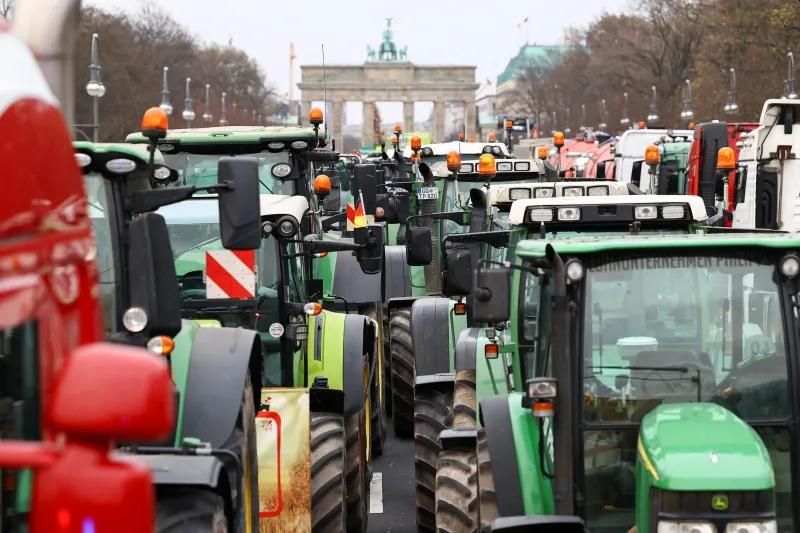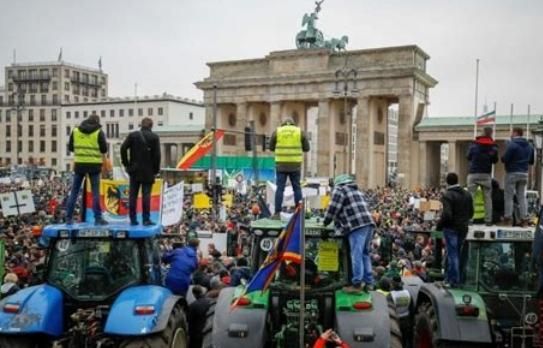By Eric Vandenbroeck and co-workers
The Farmers
From late 2023 until
the spring of 2024, farmers across Europe flooded capitals to voice their
disapproval of national and European Union policies. Tractors rolled down
boulevards as protesters blocked streets and caused havoc. The anger reached
the heart of the EU, where demonstrators brought the Brussels city center to a
standstill and pelted the European Parliament building with eggs.
The protesters had a
multitude of concerns, but chief among them was the European Green Deal,
launched by the European Commission in 2019, a package of policy initiatives
that included new restrictions on the use of pesticides, bans on
combustion engines, and the protection of biodiversity—all measures that came
with costs for farmers. Many farmers also saw the possibility of more stringent
demands on the agricultural sector to cut greenhouse gas emissions as a threat
to their livelihoods. With EU parliamentary elections slated for June, the
protests unnerved many politicians and led to the rollback of some planned
legislative changes.
But the
demonstrations did not just take the measure of farmers’ unhappiness. They were
also a manifestation of a deeper problem, a widening divide between Europe’s
rural areas and its cities. This divide may not be a chasm yet, but it is
steadily growing wider as discontent mounts in rural communities, which
constitute a quarter of Europe’s population.
Scholars have
extensively documented the economic factors fueling the drift of rural areas
away from cities. They include long-standing economic inequalities, exacerbated
by poorly conceived or poorly implemented policies that have left rural
residents often feeling ignored or disrespected. Globalization has reshaped the
geography of where people work, and cities have drawn young talent and labor
from rural areas, leading to the withering and ageing of rural societies. As a
result, the income and employment gap between rural and urban areas widened in
the last decade. Lower income levels and a lack of employment opportunities
have exacerbated rural discontent. And Europe’s recent cost-of-living crisis,
which has seen a rise in the cost of many essential items including food and
fuel, has served to further deepen these persistent disparities.
But politicians and
elites have paid less attention to the growing political and cultural divide
between rural and urban populations in Europe. Many rural residents do not feel
that their governments recognize or care about their needs. This widening “recognition
gap” (as one of us, Lamont, has described it) has potentially serious
consequences. It fosters discontent among rural residents, weakens social
cohesion, and provides fertile soil for the growth of far-right populism among
a population that already tends to harbor more traditional and conservative
values. A similar gap is evident in the United States, where tensions between
urban and rural populations contribute to political and cultural
polarization—on issues such as abortion, same-sex marriage, and views on
presidential candidate Donald Trump. This erosion of social cohesion presents a
critical challenge to the stability of many Western democracies, and it will
only grow more dangerous if left unaddressed.

The Recognition Gap
Recent research
conducted by the European Foundation for the Improvement of Living and Working
Conditions has revealed that rural residents of the EU are more likely than
their urban counterparts to believe that the government acts unfairly toward
them, ignores or cares less about people like them, and cares less about people
in their area relative to other parts of the country. For instance, 51 percent
of rural residents perceive disrespect toward their communities, while only 42
percent of urban residents do. Around 65 percent of those living in rural areas
believe that their governments do not respect people like them, compared with
58 percent of those living in cities. These differences between people in the
countryside and the cities hold even after accounting for a broad range of
other sociodemographic characteristics, including, age, gender, employment
status, and income.
Rural communities in
many parts of Europe have long suffered due to national policies that have left
many parts of the countryside struggling with poor infrastructure and limited
access to essential public services, such as health care and public transport.
But people in rural communities increasingly view this underinvestment as not
simply a failure of policy but as an indication that they are less valued, a
perception that only deepens their sense of marginalization.
These are the
cultural factors, often ignored by analysts, that feed polarization. They exist
beyond the economic factors, such as disparities in income levels. For
instance, policies that seem to favor urban populations, such as subsidies for
electric vehicles, anger rural residents who see such handouts as evidence that
the government favors wealthier people in large metropolitan agglomerations.
And policies that try to reduce transport emissions by disincentivizing the use
of private cars do not account for the lack of viable transport alternatives
outside of urban centers. Rural communities see such policies as responsible
for reinforcing the privilege of wealthier segments of the population in
national and European hierarchies—and as a measure of whose needs and
sufferings matter most, who is most worthy and deserving of attention and care.
Additionally, people
in rural areas perceive policymaking as a top-down exercise that does not allow
for their input. For example, although governments should make the expansion of
digital connectivity an important goal, they should understand that rural areas
might need different solutions than do urban ones; satellite broadband might be
more appropriate for some remote rural areas than fixed broadband
infrastructure. Consider the vast differences between the speed and quality of
Internet connections in rural and urban areas. According to data from 2022, for
example, France’s average broadband speed for fixed networks in urban areas was
219.07 megabytes per second. In rural areas, the average speed was little more
than half of that, at 128.6 megabytes per second. Perhaps even more concerning
is the fact that these disparities seem to be increasing over time. In the
great majority of EU member states, the gap in fixed network broadband speed
between rural and urban areas increased from 2019 to 2022, in some cases more
than doubling. These disparities, and the policies underlying them, further
embitter rural populations and stoke political discontent.

Centering The Hinterland
Unfortunately, many
policymakers and the media hold urban-centric biases that lead them to
deprioritize rural areas, which in turn fuels a sense in the countryside that
it counts for little among those in power in the big cities. Governments in
Europe will be able to address the growing disquiet in rural communities only
by adopting more policies that target the needs of specific communities,
account for the demands and needs of rural residents, and include these
residents in decision-making processes. Indeed, such an approach would align
well with the EU’s principle of subsidiarity, which holds that a central
authority should perform only those tasks that cannot be performed better at a
more local level.
The EU has always
hoped to achieve greater territorial cohesion by minimizing inequities between
different parts of the continent. The COVID-19 pandemic produced some trends
that have provided new opportunities to rural areas, including increased remote
and hybrid work as well as the digital provision of health care and governance.
But to make all areas of Europe attractive places to live and work, governments
will need to make large-scale investments in infrastructure and services. Rural
areas will not be able to take advantage of the growing predilection for remote
work, for instance, in the absence of high-quality digital connectivity and
public services.
This is undoubtedly a
fiscal challenge. It is more expensive per capita to deliver health care, for
example, in rural areas than in urban ones. As a result, health-care facilities
tend to be less widely available in rural areas, a particularly thorny challenge
given that rural residents tend to be older and in greater need of such
services. But governments and nongovernmental organizations are
putting in place innovative solutions across Europe. To deal with an
insufficient number of doctors in rural areas, for example, the Netherlands has
expanded the number of medical services that can be performed by nurses. In
other parts of Europe, governments have widened the responsibilities of
pharmacists and ensured that mobile health units and telehealth facilities can
bring care to underserved communities.
But such place-based
solutions need to be accompanied by “people-based” policies designed to address
the challenges faced by specific populations within rural areas. Young people
in many rural areas, for example, have to grapple with greater impediments in
their transitions to adulthood compared to their urban counterparts. They live
more often in economically deprived areas, have lower levels of education, have
less access to educational resources, and tend to enter the labor market
earlier with fewer qualifications, resulting in their being more likely to take
up precarious or informal work. Over the past decade, the NEET rate (the
percentage of young people not in employment, education, or training), which
currently stands at 11.2 percent across the EU, has been consistently higher in
rural areas. As of 2023, 12.3 percent of young people in rural areas of the EU
were NEET, compared to 10.3 percent of those living in cities. But
average figures mask particularly extreme challenges in some countries. In
Romania, the NEET rate is eight percent in cities but 27 percent in rural
areas. Similarly wide gaps exist in Bulgaria and Hungary. Ensuring that young
people in rural areas can more easily find opportunities to learn, work, and
meaningfully participate in economic activity is essential to stemming rural
depopulation, boosting social capital, and maintaining social cohesion.
Similarly, women in
rural areas experience specific challenges. EU data from 2021 show that
although rural women have higher levels of education than their male
counterparts, the gap between male and female rates of employment in rural
areas stands at 12.3 percent. This compares to a gender employment gap of 10.8
percent for the overall population. This discrepancy may partly reflect
traditional gender norms in rural areas, but policy intervention can make a
difference. Ensuring good quality childcare and public transportation in rural
areas can help women increase their participation in the labor market. Making
it easier for women to work would in turn have positive spillovers by
increasing rural household incomes and purchasing power.
Bridging The Divide
Addressing these
rural-urban inequalities will not be straightforward. Some policymakers may
resist the imperative to prioritize rural issues and tackle complex problems in
the countryside. The traditional urban-centric bias, along with bureaucratic
hurdles and complex governance structures, could slow the implementation of new
policies. Finding sufficient funding may be tricky and may require the
reallocation of resources from other policy areas. As a result, the EU and its
member states will have to summon sufficient political will to address the
divide between cities and rural areas.

That effort will also
require the coordinated intervention of many actors, including policymakers at
both the national and EU levels. These government actors need to be more
sensitive to the way processes of centralized decision-making alienate people
in rural areas. Local and national policymakers need to collaborate with rural
communities to design and implement effective solutions so that rural residents
feel a sense of ownership over new policy initiatives. EU institutions also
have an important role to play in providing both the knowledge and funding to
ensure that the most effective solutions are well implemented on the correct
scale. Furthermore, in today’s world of declining trust, EU institutions and
national governments must improve their communication with citizens by
fostering open and transparent dialogue, for instance by better including
citizens in policymaking, listening to their concerns, addressing them through
place-based policies, and ensuring clear and consistent messaging on key policies
and decisions. The threat to social cohesion posed by the rural-urban
recognition gap is so great that Europe’s governments must overcome these
challenges.
It will not be easy
to rebuild trust in rural communities and to address their perceptions of
neglect. But the potential benefits of a sustained effort to do so are
manifold. Balanced development across regions can boost overall economic
prosperity. Targeted labor market initiatives can help improve gender equality,
offset the economic impact of aging populations, raise employment levels, and
reduce labor shortages. Improving access to public services will not just help
address the logistical needs of rural dwellers but also make them feel better
recognized by the state and their fellow citizens who live in cities. Most
important, bridging the rural-urban divide in a meaningful way will help lower
the tensions now roiling many societies in the West.
For updates click hompage here